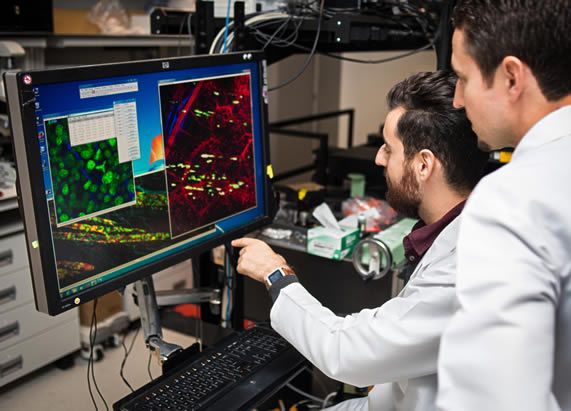MS Public Seminar: EMELY SARAI LARIOS
When & Where
October 30
2:00 PM - 3:00 PM
UTHealth MD Anderson Cancer Center 3SCR4.3202a and via Zoom (View in Google Map)
Contact
- Joy A. Lademora
- 7135009872
- [email protected]
Event Description
ATM Plays Multiple Roles in Crossover Regulation During Mouse Spermatogenesis
Emely Sarai Larios, BA (Advisor: Francesca Cole Bergemann, PhD)
During meiosis, each pair of homologous chromosomes must have at least one crossover recombination event, or they risk randomly segregating, leading to aneuploidy—a major cause of infertility, miscarriage, and birth defects. In humans, approximately 1 in 20 sperm and 1 in 4 oocytes are aneuploid many from errors in crossover formation. My work focuses on understanding how the DNA damage response kinase Ataxia Telangiectasia Mutated (ATM) might regulate crossover number, particularly in juvenile mice that exhibit reduced crossovers, referred to as the juvenile paternal age defect.
During meiosis, ATM is known to negatively regulate SPO11-generated DNA double-strand breaks (DSBs). In mice, complete loss of ATM causes spermatocyte apoptosis during mid-prophase I, likely due to unrepaired DSBs. However, the effects of modulating ATM signaling are not understood. Reducing DSBs by removing a copy of Spo11 in Atm-/- spermatocytes led to partial rescue with spermatocytes dying later in metaphase. Intriguingly, Atm-/-Spo11+/- have more crossovers than wild type spermatocytes suggesting ATM may be involved in crossing over. To explore the dosage-sensitive roles of ATM, I analyzed recombination outcomes molecularly and cytologically in juvenile and adult spermatocytes with reduced copies of Atm and Spo11.
I found that Atm heterozygosity increases axis length, DSB number, and crossovers, ultimately bypassing the juvenile paternal age defect. Comparisons of DMC1 foci that mark DSB intermediates and MLH1 foci that mark class I crossovers suggests that compromised ATM signaling disrupts crossover homeostasis, the maintenance of crossover number despite fluctuating DSBs. Strikingly, when Spo11 and Atm are both reduced, the number of MLH1 foci are lower, but these animals still bypass the juvenile paternal age defect. These findings suggest that ATM functions in a dosage-sensitive manner to restrain DSB formation, maintain crossover number, and possibly increase class II crossovers. Together, my work shows that ATM is a key regulator of meiotic recombination and provides a basis for understanding how subtle variation in ATM activity can impact crossover homeostasis and potentially fertility.
Advisory Committee:
- Francesa Cole Bergemann, PhD, Chair
- Swathi Arur, PhD
- Richard Behringer, PhD
- Rachel Miller, PhD
- Richard Wood, PhD
Join via Zoom (Please contact Ms. Larios for her Zoom meeting info.)
ATM Plays Multiple Roles in Crossover Regulation During Mouse Spermatogenesis
Emely Sarai Larios, BA (Advisor: Francesca Cole Bergemann, PhD)
During meiosis, each pair of homologous chromosomes must have at least one crossover recombination event, or they risk randomly segregating, leading to aneuploidy—a major cause of infertility, miscarriage, and birth defects. In humans, approximately 1 in 20 sperm and 1 in 4 oocytes are aneuploid many from errors in crossover formation. My work focuses on understanding how the DNA damage response kinase Ataxia Telangiectasia Mutated (ATM) might regulate crossover number, particularly in juvenile mice that exhibit reduced crossovers, referred to as the juvenile paternal age defect.
During meiosis, ATM is known to negatively regulate SPO11-generated DNA double-strand breaks (DSBs). In mice, complete loss of ATM causes spermatocyte apoptosis during mid-prophase I, likely due to unrepaired DSBs. However, the effects of modulating ATM signaling are not understood. Reducing DSBs by removing a copy of Spo11 in Atm-/- spermatocytes led to partial rescue with spermatocytes dying later in metaphase. Intriguingly, Atm-/-Spo11+/- have more crossovers than wild type spermatocytes suggesting ATM may be involved in crossing over. To explore the dosage-sensitive roles of ATM, I analyzed recombination outcomes molecularly and cytologically in juvenile and adult spermatocytes with reduced copies of Atm and Spo11.
I found that Atm heterozygosity increases axis length, DSB number, and crossovers, ultimately bypassing the juvenile paternal age defect. Comparisons of DMC1 foci that mark DSB intermediates and MLH1 foci that mark class I crossovers suggests that compromised ATM signaling disrupts crossover homeostasis, the maintenance of crossover number despite fluctuating DSBs. Strikingly, when Spo11 and Atm are both reduced, the number of MLH1 foci are lower, but these animals still bypass the juvenile paternal age defect. These findings suggest that ATM functions in a dosage-sensitive manner to restrain DSB formation, maintain crossover number, and possibly increase class II crossovers. Together, my work shows that ATM is a key regulator of meiotic recombination and provides a basis for understanding how subtle variation in ATM activity can impact crossover homeostasis and potentially fertility.
Advisory Committee:
- Francesa Cole Bergemann, PhD, Chair
- Swathi Arur, PhD
- Richard Behringer, PhD
- Rachel Miller, PhD
- Richard Wood, PhD
Join via Zoom (Please contact Ms. Larios for her Zoom meeting info.)
", "startDate":"2025-10-30", "endDate":"2025-10-30", "startTime":"14:00", "endTime":"15:00", "location":"UTHealth MD Anderson Cancer Center 3SCR4.3202a and via Zoom", "label":"Add to Calendar", "options":[ "Apple", "Google", "iCal", "Microsoft365", "MicrosoftTeams", "Yahoo" ], "timeZone":"America/Chicago", "trigger":"click", "inline":true, "listStyle":"modal", "iCalFileName":"Reminder-Event" }






